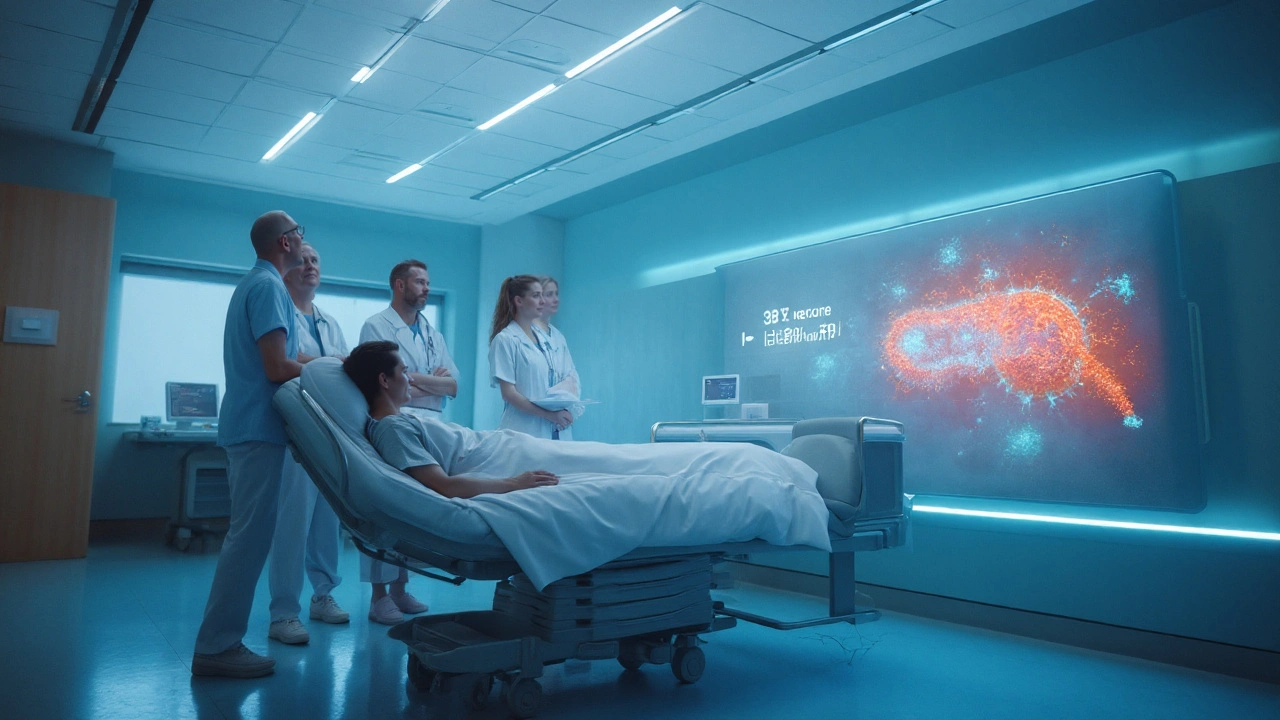Amoeba infection is a protozoan disease caused by free‑living amoebae that invade human tissues, leading to conditions such as amoebic dysentery, brain encephalitis, or keratitis. These infections have historically been hard to spot, but new labs and drugs are turning the tide.
Understanding the Main Culprits
Three genera dominate human disease:
- Entamoeba histolytica is a large intestinal parasite responsible for amoebic dysentery and liver abscesses. It affects an estimated 50million people each year.
- Naegleria fowleri is a thermotolerant amoeba that causes primary amebic meningoencephalitis (PAM) after swimming in warm freshwater. The mortality rate exceeds 95%.
- Acanthamoeba spp. are soil‑borne amoebae that can infiltrate the cornea (keratitis) or spread to the brain in immunocompromised hosts.
While these species differ in habitat and clinical picture, they share a resilience that makes them tough to eradicate.
Why Diagnosis Has Been a Bottleneck
Traditional microscopy relies on seeing parasites in stool or tissue, but that method suffers from low sensitivity (<60%) and requires expert eyes. Misdiagnosis leads to delayed therapy, especially for rapid‑acting CNS infections.
Cutting‑Edge Diagnostic Toolbox
Recent years have delivered a suite of rapid, highly sensitive tests that can be deployed in both reference labs and point‑of‑care settings.
| Method | Sensitivity | Specificity | Turnaround | Cost (USD) |
|---|---|---|---|---|
| Microscopy | 55‑65% | 80‑90% | Hours | 5‑10 |
| Antigen ELISA | 85‑92% | 88‑95% | 1‑2h | 15‑30 |
| Polymerase Chain Reaction (PCR) | 95‑99% | 98‑100% | 2‑4h | 30‑60 |
| Loop‑mediated Isothermal Amplification (LAMP) | 90‑95% | 96‑99% | 30‑60min | 20‑40 |
| Metagenomic Sequencing | 99‑>99.5% | 99‑>99.5% | 24‑48h | 200‑500 |
The table shows how PCR now dominates with near‑perfect accuracy, while LAMP offers a field‑friendly alternative. Metagenomics, though pricey, can uncover mixed infections that traditional tests miss.
Molecular Diagnostics in Action
PCR assays targeting the 16S rRNA gene of Entamoeba histolytica have cut the time to result from days to under four hours, allowing clinicians to start anti‑amoebic drugs while the patient is still stable. A recent multi‑center trial in Southeast Asia reported a 23% reduction in hospital stay when PCR‑guided therapy replaced empirical treatment.
LAMP kits designed for Naegleria fowleri can be run on a simple heat block, delivering a visual colour change that even a nurse in a remote clinic can interpret. This has already saved lives in Florida’s warm water parks, where rapid identification triggers immediate therapeutic measures.
For Acanthamoeba spp., quantitative PCR helps differentiate between contaminant DNA and true infection, guiding ophthalmologists to start topical agents before corneal scarring becomes irreversible.

Imaging and Clinical Clues
When the brain is involved, CT and MRI remain indispensable. In PAM, CT often shows diffuse edema, while MRI may reveal a characteristic “snowball” appearance of necrotic lesions. Recognising these patterns shortens the window between symptom onset and targeted therapy.
Blood markers such as elevated serum ferritin and lactate dehydrogenase (LDH) can hint at a systemic amoebic invasion, prompting faster use of molecular tests.
Therapeutic Advances: From Old‑School Drugs to Precision Regimens
Metronidazole has been the workhorse against Entamoeba histolytica for decades, delivering a cure rate above 90% when paired with a luminal agent like paromomycin. However, resistance reports in South America have spurred the search for alternatives.
Miltefosine emerged as a game‑changer for disseminated Acanthamoeba infections. A phase‑II study showed 68% survival in patients receiving a 28‑day course, compared with <10% in historic controls.
For PAM, the combination of amphotericin B, miltefosine, and the experimental drug azithromycin has pushed mortality down from >95% to around 70% in the few survivors reported from the United States.
Nanoparticle‑encapsulated drugs are now in early trials, improving brain penetration while reducing systemic toxicity. One liposomal formulation of miltefosine achieved therapeutic concentrations in cerebrospinal fluid 3‑fold higher than oral dosing.
Special Populations: Children, Immunocompromised, and Travelers
Children under five are disproportionately affected by dysentery caused by Entamoeba histolytica. Weight‑based dosing of metronidazole combined with rapid PCR screening has lowered complication rates from 12% to 4% in a Kenyan cohort.
For HIV‑positive patients, opportunistic Acanthamoeba brain infections demand prolonged therapy-often six months of high‑dose miltefosine plus flucytosine. Monitoring liver function is crucial, as drug interactions with antiretrovirals can raise toxicity.
Travel clinics now stock LAMP kits for Naegleria fowleri testing of recreational water samples, enabling quick advisories and preventing exposure during summer months.
Future Directions: Point‑of‑Care Genomics and Vaccines
Portable nanopore sequencers promise bedside identification of any amoeba species within 30minutes, eliminating the need for separate PCR primers. Pilot projects in field hospitals in Uganda have already demonstrated feasibility.
Vaccine research is nascent but encouraging. A recombinant lectin‑based candidate against Entamoeba histolytica showed a 70% reduction in infection rates in a murine model, paving the way for human trials.
Artificial‑intelligence algorithms that integrate clinical signs, imaging, and laboratory data are being trained to flag high‑risk patients earlier, potentially cutting mortality by half for cerebral infections.

Frequently Asked Questions
How fast can PCR detect Entamoeba histolytica?
Modern real‑time PCR assays deliver results in 2‑4hours from sample receipt, far quicker than culture or microscopy.
Is there a vaccine for any amoeba infection?
No licensed vaccine exists yet. Experimental lectin‑based vaccines against Entamoeba histolytica are in pre‑clinical stages and look promising.
What is the first‑line treatment for Naegleria fowleri infection?
Aggressive combination therapy-intravenous amphotericin B, oral miltefosine, and azithromycin-started as soon as diagnosis is confirmed yields the best chance of survival.
Can point‑of‑care LAMP tests replace laboratory PCR?
LAMP offers comparable sensitivity for many species and is ideal where lab infrastructure is lacking, but PCR remains the gold standard for confirmatory diagnosis.
Are amoeba infections common in the UK?
Amoebic dysentery is rare in the UK, usually linked to travel. However, Acanthamoeba keratitis has risen among contact‑lens wearers, accounting for about 15% of microbial keratitis cases.
What safety measures reduce the risk of Naegleria infection?
Avoidance of warm freshwater activities where possible, using nose clips, and ensuring water is properly chlorinated are key preventive steps.


Miriam Lohrum
September 22, 2025 AT 22:05It's fascinating how we've moved from staring at slides under a microscope to decoding entire genomes in hours. Science isn't just advancing-it's becoming intimate with the pathogens we once feared as invisible monsters.
But I wonder: if we can detect them so fast now, why do we still wait for symptoms to escalate before acting? Prevention should be as precise as diagnosis.
Gaurav Sharma
September 24, 2025 AT 10:45Highly formal observation: the data presented lacks statistical normalization across geographic regions. The Southeast Asia trial cited does not account for baseline sanitation variables. This is methodologically unsound.
Shubham Semwal
September 24, 2025 AT 12:57LMAO so now we got fancy PCR machines but people still get brain-eating amoebas from swimming in lakes? Why aren't we just boiling every damn pond in Florida? This is 2025, not 1825.
And don't even get me started on how miltefosine costs more than my rent. Who's paying for this? The rich? Again?
Sam HardcastleJIV
September 24, 2025 AT 19:12One cannot help but observe the conspicuous absence of ethical deliberation regarding the deployment of nanoparticle-based therapeutics in low-resource settings. The asymmetry between diagnostic capability and equitable access remains an unresolved moral quandary.
Mira Adam
September 25, 2025 AT 04:45You call this a breakthrough? You're celebrating tech while millions still die from dirty water and ignored symptoms. This isn't science-it's a luxury for the privileged. Fix the system before you tweak the test tubes.
archana das
September 26, 2025 AT 03:48In India, we’ve known for generations that boiling water saves lives. Now science finally catches up. But it’s not just about machines-it’s about teaching people, especially in villages, that a simple cloth filter and heat can stop these tiny killers.
Let’s make sure the future doesn’t leave behind those who can’t afford PCR.
Emma Dovener
September 26, 2025 AT 12:31For anyone with contact lenses: always clean them with sterile solution, never tap water-even if it’s ‘filtered.’ Acanthamoeba keratitis is rare, but it’s brutal, and it’s preventable. I’ve seen patients lose vision because they thought ‘it’s just water.’ Don’t be that person.
Sue Haskett
September 27, 2025 AT 12:10Wait-wait-wait-I just need to say this: LAMP tests in remote clinics? That’s huge. That’s life-changing. That’s not just science, that’s justice. And the nanoparticle delivery? Genius. But please, someone tell the WHO to stop hoarding these technologies in labs and get them into the hands of nurses in Uganda, in Bihar, in rural Texas.
Because knowledge without access? It’s just a fancy footnote in a textbook.
Jauregui Goudy
September 28, 2025 AT 05:33Okay, real talk-this whole post made me feel like I’m watching a superhero movie where the villain is a microscopic blob that eats your brain.
But here’s the twist: the real hero isn’t the drug or the machine-it’s the nurse in Florida who sees a kid with a headache after swimming and says, ‘I’m running a LAMP test, no waiting.’ That’s what saves lives.
And yeah, vaccines are coming. But until then? Let’s celebrate the people who show up, not just the tech that dazzles.
Also-naegleria doesn’t care if you’re rich or poor. It just wants warm water and a nose. So wear the clip. Please.